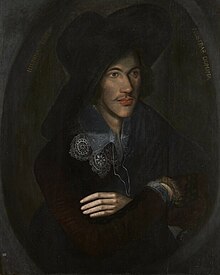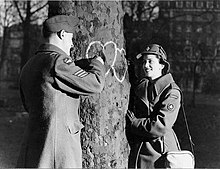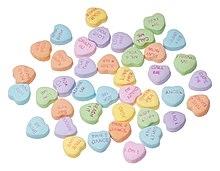Valentine's Day
Court of love
The earliest description of February 14 as an annual celebration of love appears in the Charter of the Court of Love. The charter, allegedly issued by Charles VI of France at Mantes-la-Jolie in 1400, describes lavish festivities to be attended by several members of the royal court, including a feast, amorous song and poetry competitions, jousting and dancing.[62] Amid these festivities, the attending ladies would hear and rule on disputes from lovers.[63] No other record of the court exists, and none of those named in the charter were present at Mantes except Charles's queen, Isabeau of Bavaria, who may well have imagined it all while waiting out a plague.[62]
Valentine poetry
The earliest surviving valentine is a 15th-century rondeau written by Charles, Duke of Orléans to his wife, which commences.
"Je suis desja d'amour tanné
Ma tres doulce Valentinée..."
— Charles d'Orléans, Rondeau VI, lines 1–2[64]
At the time, the duke was being held in the Tower of London following his capture at the Battle of Agincourt, 1415.[65]
The earliest surviving valentines in English appear to be those in the Paston Letters, written in 1477 by Margery Brewes to her future husband John Paston "my right well-beloved Valentine".[66]
Valentine's Day is mentioned ruefully by Ophelia in William Shakespeare's Hamlet (1600–1601):
"To-morrow is Saint Valentine's day,
All in the morning betime,
And I a maid at your window,
To be your Valentine.
Then up he rose, and donn'd his clothes,
And dupp'd the chamber-door;
Let in the maid, that out a maid
Never departed more."
— William Shakespeare, Hamlet, Act IV, Scene 5
 Noted poet John Donne, c. 1595.
Noted poet John Donne, c. 1595.
John Donne used the legend of the marriage of the birds as the starting point for his epithalamion celebrating the marriage of Elizabeth, daughter of James I of England, and Frederick V, Elector Palatine, on Valentine's Day:
"Hayle Bishop Valentine whose day this is
All the Ayre is thy Diocese
And all the chirping Queristers
And other birds ar thy parishioners
Thou marryest every yeare
The Lyrick Lark, and the graue whispering Doue,
The Sparrow that neglects his life for loue,
The houshold bird with the redd stomacher
Thou makst the Blackbird speede as soone,
As doth the Goldfinch, or the Halcyon
The Husband Cock lookes out and soone is spedd
And meets his wife, which brings her feather-bed.
This day more cheerfully than ever shine
This day which might inflame thy selfe old Valentine."
— John Donne, Epithalamion Vpon Frederick Count Palatine and the Lady Elizabeth marryed on St. Valentines day
The verse "Roses are red" echoes conventions traceable as far back as Edmund Spenser's epic The Faerie Queene (1590):
"She bath'd with roses red, and violets blew,
And all the sweetest flowres [sic], that in the forrest grew."[67]
The modern cliché Valentine's Day poem can be found in Gammer Gurton's Garland (1784), a collection of English nursery rhymes published in London by Joseph Johnson:
"The rose is red, the violet's blue,
The honey's sweet, and so are you.
Thou art my love and I am thine;
I drew thee to my Valentine:
The lot was cast and then I drew,
And Fortune said it shou'd be you."[68][69]
Modern times
 An English Victorian era Valentine card located in the Museum of London
An English Victorian era Valentine card located in the Museum of London
In 1797, a British publisher issued The Young Man's Valentine Writer, which contained scores of suggested sentimental verses for the young lover unable to compose his own. Printers had already begun producing a limited number of cards with verses and sketches, called "mechanical valentines". Paper Valentines became so popular in England in the early 19th century that they were assembled in factories. Fancy Valentines were made with real lace and ribbons, with paper lace introduced in the mid-19th century.[70] In 1835, 60,000 Valentine cards were sent by post in the United Kingdom, despite postage being expensive.[71]
A reduction in postal rates following Sir Rowland Hill's postal reforms with the 1840 invention of the postage stamp (Penny Black) saw the number of Valentines posted increase, with 400,000 sent just one year after its invention, and ushered in the less personal but easier practice of mailing Valentines.[72] That made it possible for the first time to exchange cards anonymously, which is taken as the reason for the sudden appearance of racy verse in an era otherwise prudishly Victorian.[73] Production increased, "Cupid's Manufactory" as Charles Dickens termed it, with over 3,000 women employed in manufacturing.[72] The Laura Seddon Greeting Card Collection at Manchester Metropolitan University gathers 450 Valentine's Day cards dating from early nineteenth century Britain, printed by the major publishers of the day.[74] The collection appears in Seddon's book Victorian Valentines (1996).[75] Flowers, such as red roses (pictured), are often sent on Valentine's Day.
Flowers, such as red roses (pictured), are often sent on Valentine's Day.
In the United States, the first mass-produced Valentines of embossed paper lace were produced and sold shortly after 1847 by Esther Howland (1828–1904) of Worcester, Massachusetts.[76][77] Her father operated a large book and stationery store, but Howland took her inspiration from an English Valentine she had received from a business associate of her father.[78][79] Intrigued with the idea of making similar Valentines, Howland began her business by importing paper lace and floral decorations from England.[79][80]
A writer in Graham's American Monthly observed in 1849, "Saint Valentine's Day ... is becoming, nay it has become, a national holyday."[81] The English practice of sending Valentine's cards was established enough to feature as a plot device in Elizabeth Gaskell's Mr. Harrison's Confessions (1851): "I burst in with my explanations: 'The valentine I know nothing about.' 'It is in your handwriting', said he coldly."[82] Since 2001, the Greeting Card Association has been giving an annual "Esther Howland Award for a Greeting Card Visionary".[77]
Since the 19th century, handmade cards have given way to mass-produced greeting cards.[12] In the UK, just under half of the population spend money on their Valentines, and around £1.9 billion was spent in 2015 on cards, flowers, chocolates, and other gifts.[83] The mid-19th century Valentine's Day trade was a harbinger of further commercialized holidays in the U.S. to follow.[84] A gift box of chocolates, which is a common gift for Valentine's Day
A gift box of chocolates, which is a common gift for Valentine's Day
In 1868, the British chocolate company Cadbury created Fancy Boxes – a decorated box of chocolates – in the shape of a heart for Valentine's Day.[85][86] Boxes of filled chocolates quickly became associated with the holiday.[85] In the second half of the 20th century, the practice of exchanging cards was extended to all manner of gifts, such as giving jewelry.
The U.S. Greeting Card Association estimates that approximately 190 million valentines are sent each year in the US. Half of those valentines are given to family members other than husband or wife, usually to children. When the valentine-exchange cards made in school activities are included the figure goes up to 1 billion, and teachers become the people receiving the most valentines.[76] The average valentine's spending has increased every year in the U.S., from $108 a person in 2010 to $131 in 2013.[87]
The rise of Internet popularity at the turn of the millennium is creating new traditions. Millions of people use, every year, digital means of creating and sending Valentine's Day greeting messages such as e-cards, love coupons or printable greeting cards. Valentine's Day is considered by some to be a Hallmark holiday due to its commercialization.[88]
In the modern era, liturgically, the Lutheran Church and Anglican Church have a service for St. Valentine's Day (the Feast of St. Valentine), which includes the optional rite of the renewal of marriage vows.[89][90] In 2016, the Catholic Bishops of England and Wales established a novena prayer "to support single people seeking a spouse ahead of St Valentine's Day."[91]
Celebration and status worldwide
 A Canadian Women's Army Corps member and a man in the Canadian Air Force chalk hearts on a tree on Valentine's Day 1944
A Canadian Women's Army Corps member and a man in the Canadian Air Force chalk hearts on a tree on Valentine's Day 1944
Valentine's Day customs – sending greeting cards (known as "valentines"), offering confectionery and presenting flowers – developed in early modern England and spread throughout the English-speaking world in the 19th century. In the later 20th and early 21st centuries, these customs spread to other countries, like those of Halloween, or aspects of Christmas (such as Santa Claus).
Valentine's Day is celebrated in many East Asian countries with Singaporeans, Chinese and South Koreans spending the most money on Valentine's gifts.[92]
Americas
Latin America
In most Latin American countries, for example, Costa Rica,[93] Mexico,[94] and the U.S. territory of Puerto Rico, Saint Valentine's Day is known as Día de los Enamorados ('Day of Lovers')[95] or as Día del Amor y la Amistad ('Day of Love and Friendship'). It is also common to see people perform "acts of appreciation" for their friends.[96]
In Guatemala it is known as Día del Cariño ('Affection Day').[97] Some countries, in particular the Dominican Republic and El Salvador,[98] have a tradition called Amigo secreto ("Secret friend"), which is a game similar to the Christmas tradition of Secret Santa.[96]
Brazil
Main article: Dia dos Namorados
In Brazil, the Dia dos Namorados (lit. "Lovers' Day", or "Boyfriends'/Girlfriends' Day") is celebrated on June 12, probably because that is the day before Saint Anthony's day, known there as the 'marriage saint',[citation needed] when traditionally many single women perform popular rituals, called simpatias, in order to find a good husband or boyfriend. Couples exchange gifts, chocolates, cards, and flower bouquets. The February 14 Valentine's Day is not celebrated at all because it is usually too close to Brazilian Carnival, which can fall anywhere from early February to early March and lasts almost a week.[99]
Colombia
Colombia celebrates Día del amor y la amistad on the third Saturday in September instead.[100] Amigo Secreto is also popular there.[101]
United States
 Conversation hearts, candies with messages on them, are strongly associated with Valentine's Day in the United States.
Conversation hearts, candies with messages on them, are strongly associated with Valentine's Day in the United States. African American Valentine's school dance, Richmond, Virginia 1956
African American Valentine's school dance, Richmond, Virginia 1956
On the United States mainland, about 190 million Valentine's Day cards are sent each year, not including the hundreds of millions of cards school children exchange.[102]
Valentine's Day is a major source of economic activity, with total expenditures in 2017 topping $18.2 billion in 2017, or over $136 per person.[103] This is an increase from $108 per person in 2010.[87] In 2019, a survey by the National Retail Federation found that over the previous decade, the percentage of people who celebrate Valentine's Day had declined steadily. From their survey results, they found three primary reasons: over-commercialization of the holiday, not having a significant other, and not being interested in celebrating it.[104]
Asia
Afghanistan
In pre-Taliban years, Koch-e-Gul-Faroushi (Flower Street) in downtown Kabul used to be adorned with innovative flower arrangements, to attract the Valentine's Day-celebrating youth.[105] In the Afghan tradition, love is often expressed through poetry. A new generation of budding poets such as Ramin Mazhar and Mahtab Sahel express themselves through poetry using Valentine's Day as a theme, to voice concerns about the erosion of freedoms. In their political commentary they defy fear by saying 'I kiss you amid the Taliban'.[106][107]
Bangladesh
Main article: Valentine's Day in Bangladesh
Valentine's Day was first celebrated in Bangladesh by Shafik Rehman, a journalist and editor of Jaijaidin in 1993. He was acquainted with Western culture by studying in London.[108] He highlighted Valentine's Day to the Bangladeshi people through Jaijaidin newspaper. Rehman is called the "father of Valentine's Day in Bangladesh".[109] On this day, people in various bonds including lovers, friends, husbands and wives, mothers and children, students and teachers express their love for each other with flowers, chocolates, cards and other gifts. On this day, various parks and recreation centers of the country are full of people of love.[110][111] No public holiday is declared on this day in Bangladesh.
Some in Bangladesh feel that celebrating this day is not acceptable from a cultural and Islamic point of view.[112] Before the celebration of Valentine's Day, February 14 was celebrated as the anti-authoritarian day in Bangladesh. However, that day is disregarded by people to celebrate Valentine's Day.[113][114][115]






























